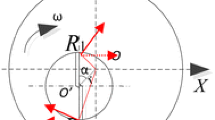Abstract
A new model for cutting force estimation is presented in this paper. It is based on the specific cutting force coefficient, which is defined as a function of chip thickness. The distinguishing feature of the proposed cutting force model is the use of average chip thickness for cutting force calculation on each position of the cutting tool, in such a way that only one iteration is needed on every angular position of the tool. This model is based on the actual workpiece–tool interaction which provides information about the real position of the cutting edge. It provides an alternative to other studies in scientific literature commonly based on numerical integrations. With this model, it is possible to estimate the cutting forces not only under steady-state conditions but also under variable machining conditions of axial and radial depth of cut.
Similar content being viewed by others
References
Armarego E, Deshpande N (1991) Computerized end milling force predictions with cutting models allowing for eccentricity and cutter deflections. Ann CIRP 40(1):25–29
Armarego E, Deshpande N (1993) Force prediction models and CAD/CAM software for helical tooth milling processes. I. Basic approach and cutting analyses. Int J Prod Res 31(10):1991–2009
Armarego E, Deshpande N (1993) Force prediction models and CAD/CAM software for helical tooth milling processes. II. Peripheral milling operations. Int J Prod Res 31(8):2319–2336
Armarego E, Deshpande N (1994) Force prediction models and CAD/CAM software for helical tooth milling processes. III. End milling and slotting operations. Int J Prod Res 32(7):1715–1738
Li H, Liu K, Li X (2001) A new method for determining the undeformed chip thickness in milling. J Mater Process Technol 113(1–3):378–384
Liang S, Wang J (1994) Milling force convolution modeling for identification of cutter axis offset. Int J Mach Tool Manuf 34(8):1177–1190
Wang M, Zheng C (2003) Identification of cutter offset in end milling without a prior knowledge of cutting coefficients. Int J Mach Tool Manuf 43(7):687–697
Altintas Y, Chan P (1992) In-process detection and suppression of chatter in milling. Int J Mach Tool Manuf 32(3):329–347
Diez E, Perez H, Guzman M, Vizan A (2010) Dynamic analysis of runout correction in milling. Int J Mach Tool Manuf 50:709–717
Diez E, Perez H, Guzman M, Vizan A (2013) An improved methodology for the experimental evaluation of tool runout in peripheral milling. Int J Adv Manuf Tech 65:283–293
Yun W, Cho D (2000) An improved method for the determination of 3D cutting force coefficients and runout parameters in end milling. Int J Adv Manuf Technol 16:851–858
Kline W, DeVor R, Lindberg J (1982) The prediction of cutting forces in end milling with application to cornering cuts. Int J Mach Tool Des Res 22(1):7–22
Gradisek J, Kalveram M, Weinert K (2004) Mechanistic identification of specific force coefficients for a general end mill. Int J Mach Tool Manuf 44:401–414
Gonzalo O, Beristain J, Jauregi H, Sanz C (2010) A method for the identification of the specific force coefficients for mechanistic milling simulation. Int J Mach Tool Manuf 50:765–774
Ko JH, Cho DW (2005) 3D ball-end milling force model using instantaneous cutting force coefficient. J Manuf Sci Eng ASME 27:1–12
Wan M, Zhang W, Qin G, Tan G (2007) Efficient calibration of instantaneous cutting force coefficients and runout parameters for general end mills. Int J Mach Tool Manuf 47:1767–1776
Wan M, Zhang W, Dang J, Yang Y (2009) New procedures for calibration of instantaneous cutting force coefficients and cutter runout parameters in peripheral milling. Int J Mach Tool Manuf 49:1144–1151
Altintas Y, Spence A, Tlusty J (1991) End milling force algorithms for CAD systems. CIRP Ann Manuf Technol 40:31–34
Budak E, Altintas Y, Armarego E (1996) Prediction of milling force coefficients from orthogonal cutting data, transactions of the ASME. J Manuf Sci Eng 118:216–224
Kienzle O (1952) Die Bestimmung von Kraften und Leistungen an spanenden Werkzeugen und Werkzeugmaschinen. Verein Deutscher Ingenieur VDI-Z 94(11–12):299–305
Sabberwal A (1961) Chip section and cutting force during the milling operation. CIRP Ann 10:197–203
Tlusty J, MacNeil P (1975) Dynamic of cutting forces in end milling. Annals of the CIRP 24(1):21–25
Koenigsberger F, Sabberwal A (1961) An investigation into the cutting force pulsations during milling operations. Int J Mach Tool Des Res 1:15–33
Yang L, DeVor R, Kapoor S (2005) Analysis of force shape characteristics and detection of depth of cut variations in end milling. J Manuf Sci Eng ASME 127:454–462
Kline W, DeVor R (1983) The effect of runout on cutting geometry and forces in end milling. Int J Mach Tool Manuf 23:123–140
Author information
Authors and Affiliations
Corresponding author
Rights and permissions
About this article
Cite this article
Perez, H., Diez, E., Marquez, J.J. et al. An enhanced method for cutting force estimation in peripheral milling. Int J Adv Manuf Technol 69, 1731–1741 (2013). https://doi.org/10.1007/s00170-013-5153-0
Received:
Accepted:
Published:
Issue Date:
DOI: https://doi.org/10.1007/s00170-013-5153-0



